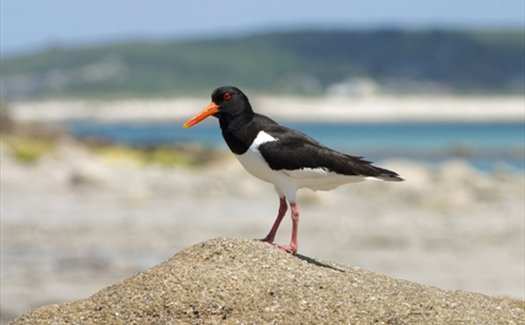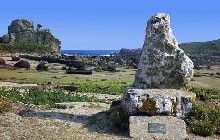
Nature
Oystercatchers for company on St. Martin's
History
From shipwrecks to treasure, and from burial chambers to deserted villages, the history of Scilly is utterly compelling – especially as it mingles so tantalisingly with modern-day life on the islands.
Scilly’s tiny land mass is home to 239 scheduled monuments, which means there is a greater density of historical sites here than any where else in the British Isles.
Traces of human life on Scilly stretch back at least 3,000 years, when the islands were one large land-mass that was home to nomadic hunter-gatherers; their flint tools still sometimes turn up today, on beaches and in fields.
Fascinating finds from subsequent years plot the rich history of these tiny islands, and many can be seen at the wonderful Isles of Scilly Museum on St Mary’s – full details at www.iosmuseum.org. Alternatively, take a guided walk to uncover the hidden history of Scilly – more information can be found at www.scillywalks.co.uk.
HISTORICAL HIGHLIGHTS
- Bant’s Carn, St Mary’s - an entrance grave dating from the Bronze Age
- Halangy Down ancient village, St Mary’s – an iron-age settlement
- St Helen’s, Tean and St Martin’s – remains of early Christian chapels
- Standing stones at Long Rock, St Mary’s, the Old Man of Gugh and the menhir on Chapel Down, St Martin’s
- Submerged prehistoric huts and field boundaries off Samson, Tresco, Bryher and Tean
- Tudor and Civil War castles on St Mary’s (Star Castle) and Tresco (Cromwell’s Castle)
Scilly's natural history means it looks and feels quite different to the rest of Britain, and the entire coastline of our archipelago is described as a 'Heritage Coast'.

Everywhere you turn in Scilly, the past and present come together. Both maritime history and archaeology impact on traditions and folklaw and have all left their mark on today's landscape.
A 'living community' which welcomes all, rich in traditional values, islanders have great respect for their cultural heritage. Gig racing, a sport born from pilotage is a popular pastime and all Scillonian families have a strong link to the sea.
Islanders are proud, resourceful and independent- minded, and are a testimony to their ansestors who adapted to the changing circumstances of history.
Today the traditional industries of flower farming and fishing continue along side tourism.

Flower farmers maintain a patchwork of fields bright yellow with colour from October onwards. Along side this farmers diversify into harvesting herbs for essential oils and free range beef and dairy faming.
Fishermen haul their catch and land the finest shellfish, lobster, crawfish, crab. Other fish such as john dory, megrim, and macerel, and also landed here and island chef's make the most of these delicious catches. You can buy fresh fish right on thequayside somedays.
.
Number of items:
Number of items: 33
, currently showing 1 to 10.
Isles of Scilly Museum
Type
Museum
St. Mary's
The Isles of Scilly Museum; The A-Z of Scilly. Archaeology to Zoology. Outstanding exhibits. Excellent archives.
Bant's Carn Burial Chamber and Halangy Down Ancient Village
Type
Historic Site
The remains of an ancient Iron Age village in a wonderfully scenic location. On the hill above stands a Bronze Age burial mound with entrance passage and inner chamber.
Hugh House
St Mary's
Overlooking the sandy isthmus of Hugh Town, the current offices of the Duchy of Cornwall were built in 1792 as the Officers' Mess
Bar Point
Type
Beach
Between McFarland's Down and the Innisidgen Bronze Age Tombs, you will find Bar Point, one of St. Mary's most scenic and sandy beaches. Jutting out into the sea, with spectacular views, the underwater sand bar streches from here to St. Martin's and Tresco and is the location of a former,...
Higher Moors Nature Trail
Type
Country Park/Nature Reserve
St Mary's
This site exhibits a wide diversity of habitats with several rare and notable plant species. The pond and fringing habitats are also of particular importance for breeding and migrant birds.
The site contains the largest area of open water on St Mary's, which supports a wide range of aquatic...
Hell Bay
Type
Viewpoint
Bryher's dramatic north-western seaboard is perfect for a stroll and the coast here is dotted with sites of old wrecks. Nowhere has a more fearsome reputation than the aptly-named Hell Bay, at the northern tip of this coastline. In heavy seas, huge rollers plough into the bay, turning it into a...
Harry's Walls
An unfinished fort in the care of English Heritage. Though named Harry's Walls, it was begun in 1551, during the reign of Edward VI. An early plan shows it was intended to be square with acutely angled bastions at each corner - an Italian design reflecting the increasing use of cannon. Internal...
Great Bay
Type
Beach
There is a raw beauty and remoteness to this gorgeous beach, nestled on the north side of the island. Great Bay is a vast expanse of creamy sand and was recently voted Best Beach in the UK; not to be missed
Bishop Rock Lighthouse
Type
Lighthouse
The lighthouse was first built (1847-50) as an open iron structure, but when destroyed by a violent storm before recieving its light, it was rebuilt (1851-58) in stone. Even this was not strong enough and in 1881 the tower was heightened and given an outer casing of stone. Light was provided by an...
Buzza Tower
Type
Tower
St Mary's
Previously called King Edward's Tower this well know landmark has been maintained since 1912 as a memorial to the King's visit, but was originally a windmill built in 1834 to replace the earlier Peninnis Mill. It stands on a kerbed platform which probably incorporates the remains of a Bronze Age...


 button to add an item to your Itinerary basket.
button to add an item to your Itinerary basket.






